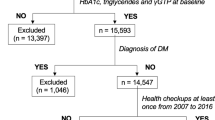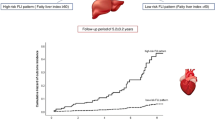Abstract
Fatty liver has been suggested to be associated with the development of hypertension. However, whether this association is related to glycemia has not been elucidated. Therefore, we investigated whether the fatty liver index (FLI) predicts the development of hypertension among individuals with and without dysglycemia in a general Japanese population. A total of 3114 participants (1036 males and 2078 females) without hypertension who underwent a Specific Health Checkup in the fiscal year 2013 were followed up until 2018. The participants were divided into six groups based on FLI tertiles (low, moderate, or high) and whether they had dysglycemia. We estimated the hazard ratios (HRs) of each group by sex using the Cox proportional hazard model. Models were adjusted for age, low-density lipoprotein cholesterol, high-density lipoprotein cholesterol, smoking, and alcohol consumption and further adjusted for systolic blood pressure (SBP). During the mean follow-up period of 2.8 years, 160 of the 3114 participants developed hypertension. Using the low FLI group with normoglycemia as a reference, the HR for incident hypertension was increased in the high FLI group with and without dysglycemia in both sexes after adjusting for confounders, except SBP (HR [95% confidence interval]: male: 1.52 (1.06–2.17) in normoglycemia and 2.05 (1.43–2.92) in dysglycemia, and female: 1.86 (1.43–2.42) in normoglycemia and 2.98 (2.19–4.07) in dysglycemia). Furthermore, in females, this association was observed after adjusting for SBP. We concluded that FLI was independently associated with an increased risk of incident hypertension in individuals with and without dysglycemia.

This is a preview of subscription content, access via your institution
Access options
Subscribe to this journal
Receive 12 print issues and online access
$259.00 per year
only $21.58 per issue
Buy this article
- Purchase on Springer Link
- Instant access to full article PDF
Prices may be subject to local taxes which are calculated during checkout
Similar content being viewed by others
References
Powell EE, Wong VWS, Rinella M. Non-alcoholic fatty liver disease. Lancet. 2021;397:2212–24.
Sung KC, Wild SH, Byrne CD. Resolution of fatty liver and risk of incident diabetes. J Clin Endocrinol Metab. 2013;98:3637–43.
Balkau B, Lange C, Vol S, Fumeron F, Bonnet F. Nine-year incident diabetes is predicted by fatty liver indices: the French D.E.S.I.R. study. BMC Gastroenterol. 2010;10:56.
Kim CH, Park JY, Lee KU, Kim JH, Kim HK. Fatty liver is an independent risk factor for the development of Type 2 diabetes in Korean adults. Diabet Med. 2008;25:476–81.
Sung KC, Wild SH, Byrne CD. Development of new fatty liver, or resolution of existing fatty liver, over five years of follow-up, and risk of incident hypertension. J Hepatol. 2014;60:1040–5.
Ryoo JH, Suh YJ, Shin HC, Cho YK, Choi JM, Park SK. Clinical association between non-alcoholic fatty liver disease and the development of hypertension. J Gastroenterol Hepatol. 2014;29:1926–31.
Lau K, Lorbeer R, Haring R, Schmidt CO, Wallaschofski H, Nauck M, et al. The association between fatty liver disease and blood pressure in a population-based prospective longitudinal study. J Hypertens. 2010;28:1829–35.
Yusuf S, Joseph P, Rangarajan S, Islam S, Mente A, Hystad P, et al. Modifiable risk factors, cardiovascular disease, and mortality in 155 722 individuals from 21 high-income, middle-income, and low-income countries (PURE): a prospective cohort study. Lancet. 2020;395:795–808.
Bedogni G, Bellentani S, Miglioli L, Masutti F, Passalacqua M, Castiglione A, et al. The fatty liver index: a simple and accurate predictor of hepatic steatosis in the general population. BMC Gastroenterol. 2006;6:33.
Sviklāne L, Olmane E, Dzērve Z, Kupčs K, Pīrāgs V, Sokolovska J. Fatty liver index and hepatic steatosis index for prediction of non-alcoholic fatty liver disease in type 1 diabetes. J Gastroenterol Hepatol. 2018;33:270–6.
Calori G, Lattuada G, Ragogna F, Garancini MP, Crosignani P, Villa M, et al. Fatty liver index and mortality: the Cremona study in the 15th year of follow-up. Hepatology. 2011;54:145–52.
Kadowaki S, Miura K, Kadowaki T, Fujiyoshi A, El-Saed A, Masaki KH, et al. International comparison of abdominal fat distribution among four populations: the ERA-JUMP study. Metab Syndr Relat Disord. 2018;16:166–73.
Huh JH, Ahn SV, Koh SB, Choi E, Kim JY, Sung KC, et al. A prospective study of fatty liver index and incident hypertension: the KoGES-ARIRANG study. PLoS ONE. 2015;10:e0143560 https://doi.org/10.1371/journal.pone.0143560.
Higashiura Y, Furuhashi M, Tanaka M, Takahashi S, Mori K, Miyamori D, et al. Elevated fatty liver index is independently associated with new onset of hypertension during a 10-year period in both male and female subjects. J Am Heart Assoc. 2021;10:e012430 https://doi.org/10.1161/JAHA.121.021430.
Kaneyama A, Hirata A, Hirata T, Imai Y, Kuwabara K, Funamoto M, et al. Impact of hypertension and diabetes on the onset of chronic kidney disease in a general Japanese population. Hypertens Res (e-pub ahead of print 28 September 2022; https://doi.org/10.1038/s41440-022-01041-9).
Hirata A, Sugiyama D, Kuwabara K, Hirata T, Tsutatani H, Funamoto M, et al. Fatty liver index predicts incident diabetes in a Japanese general population with and without impaired fasting glucose. Hepatol Res. 2018;48:708–16.
Specific Health Checkups and Specific Guidance (in Japanese). https://www.mhlw.go.jp/seisakunitsuite/bunya/kenkou_iryou/kenkou/seikatsu/dl/hoken-program1.pdf. Accessed 12 September 2022.
Wang F, Han L, Hu D. Fasting insulin, insulin resistance and risk of hypertension in the general population: a meta-analysis. Clini Chim Acta. 2017;464:57–63.
Sasaki N, Maeda R, Ozono R, Yoshimura K, Nakano Y, Higashi Y. Adipose tissue insulin resistance predicts the incidence of hypertension: The Hiroshima Study on Glucose Metabolism and Cardiovascular Diseases [published online ahead of print, 2022 Aug 10]. Hypertens Res. https://doi.org/10.1038/s41440-022-00987-0.
Muntzel MS, Anderson EA, Johnson AK, Mark AL. Mechanisms of insulin action on sympathetic nerve activity. Clin Exp Hypertens. 1995;17:39–50.
Liu Z. The renin-angiotensin system and insulin resistance. Curr Diab Rep. 2007;7:34–42.
Grundy SM. Inflammation, hypertension, and the metabolic syndrome. JAMA. 2003;290:3000–2.
Dinh QN, Drummond GR, Sobey CG, Chrissobolis S. Roles of inflammation, oxidative stress, and vascular dysfunction in hypertension. Biomed Res Int. 2014;2014:406960.
Sasaki N, Ozono R, Higashi Y, Maeda R, Kihara Y. Association of insulin resistance, plasma glucose level, and serum insulin level with hypertension in a population with different stages of impaired glucose metabolism. J Am Heart Assoc. 2020;9:e015546 https://doi.org/10.1161/JAHA.119.015546.
Targher G, Bertolini L, Rodella S, Tessari R, Zenari L, Lippi G, et al. Nonalcoholic fatty liver disease is independently associated with an increased incidence of cardiovascular events in type 2 diabetic patients. Diabetes Care. 2007;30:2119–21.
Anstee QM, Targher G, Day CP. Progression of NAFLD to diabetes mellitus, cardiovascular disease or cirrhosis. Nat Rev Gastroenterol Hepatol. 2013;10:330–44.
Lomonaco R, Bril F, Portillo-Sanchez P, Ortiz-Lopez C, Orsak B, Biernacki D, et al. Metabolic impact of nonalcoholic steatohepatitis in obese patients with type 2 diabetes. Diabetes Care. 2016;39:632–8.
Siafi E, Andrikou I, Thomopoulos C, Konstantinidis D, Kakouri N, Tatakis F, et al. Fatty liver index and cardiovascular outcomes in never-treated hypertensive patients: a prospective cohort [published online ahead of print, 2022 Oct 14]. Hypertens Res. 2022; https://doi.org/10.1038/s41440-022-01015-x.
Peng H, Yeh F, de Simone G, Best LG, Lee ET, Howard BV, et al. Relationship between plasma plasminogen activator inhibitor-1 and hypertension in American Indians: findings from the Strong Heart Study. J Hypertens. 2017;35:1787–93.
Ardigò D, Franzini L, Valtueña S, Numeroso F, Piatti PM, Monti L, et al. The increase in plasma PAI-1 associated with insulin resistance may be mediated by the presence of hepatic steatosis. Atherosclerosis. 2010;208:240–5.
Lee CH, Han KD, Kim DH, Kwak MS. The repeatedly elevated fatty liver index is associated with increased mortality: a population-based cohort study. Front Endocrinol (Lausanne). 2021;12:638615.
Younossi ZM. Non-alcoholic fatty liver disease–A global public health perspective. J Hepatol. 2019;70:531–44.
Umemura S, Arima H, Arima S, Asayama K, Dohi Y, Hirooka Y, et al. The Japanese Society of Hypertension Guidelines for the Management of Hypertension (JSH 2019). Hypertens Res. 2019;42:1235–481.
Tanaka J, Kurisu A, Ohara M, Ouoba S, Ohisa M, Sugiyama A, et al. Burden of chronic hepatitis B and C infections in 2015 and future trends in Japan: a simulation study. Lancet Reg Health West Pac. 2022;22:100428.
Yang BL, Wu WC, Fang KC, Wang YC, Huo TI, Huang YH, et al. External validation of fatty liver index for identifying ultrasonographic fatty liver in a large-scale cross-sectional study in Taiwan. PLoS ONE. 2015;10:e0120443. https://doi.org/10.1371/journal.pone.0120443.
Acknowledgements
The authors would like to thank the staff at the Habikino City Municipal Office for their important contributions.
Funding
This study was supported by JST SPRING (grant no: JPMJSP2123) and Comprehensive Research on Cardiovascular and LifeStyle Related Disease from the Ministry of Health, Labour and Welfare: 22FA1006.
Author information
Authors and Affiliations
Corresponding author
Ethics declarations
Conflict of interest
The authors declare no competing interests.
Additional information
Publisher’s note Springer Nature remains neutral with regard to jurisdictional claims in published maps and institutional affiliations.
Rights and permissions
Springer Nature or its licensor (e.g. a society or other partner) holds exclusive rights to this article under a publishing agreement with the author(s) or other rightsholder(s); author self-archiving of the accepted manuscript version of this article is solely governed by the terms of such publishing agreement and applicable law.
About this article
Cite this article
Wu, D., Hirata, A., Hirata, T. et al. Fatty liver index predicts the development of hypertension in a Japanese general population with and without dysglycemia. Hypertens Res 46, 879–886 (2023). https://doi.org/10.1038/s41440-022-01161-2
Received:
Revised:
Accepted:
Published:
Issue Date:
DOI: https://doi.org/10.1038/s41440-022-01161-2
Keywords
This article is cited by
-
Fatty liver index has potential as a predictor of hypertension in the Japanese general population
Hypertension Research (2023)
-
The importance of lifestyle modification for hypertension in Asia
Hypertension Research (2023)



